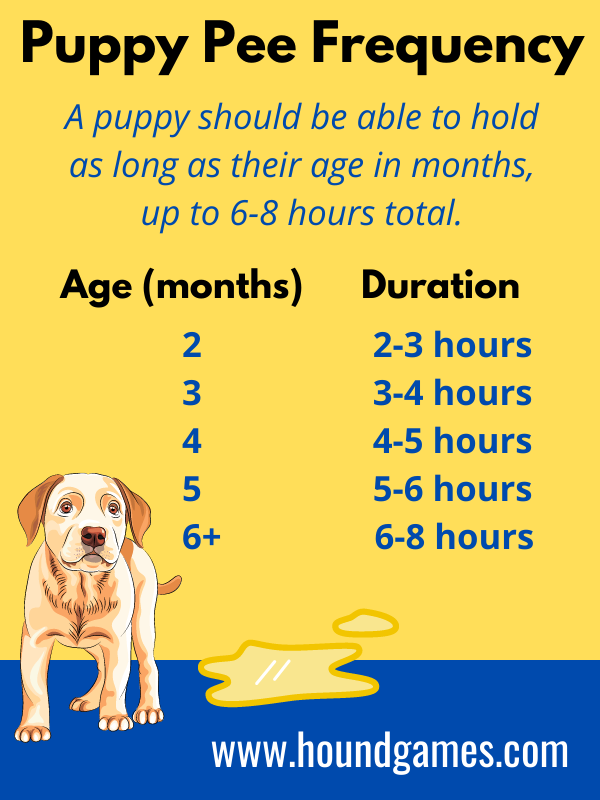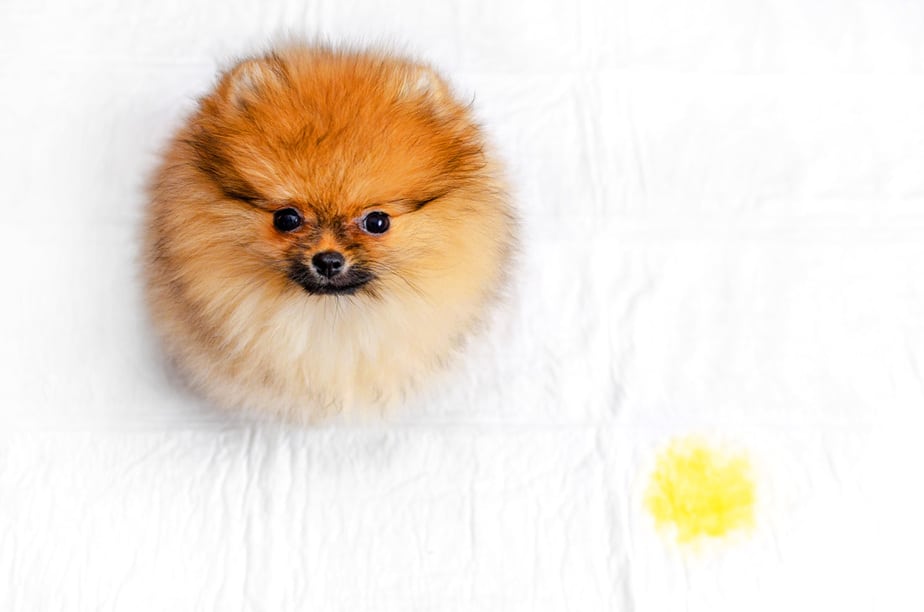As with most mammals, puppies are born before they’re fully developed. During their first year of life, they will continue to grow and develop until they are 1-2 years of age. And a puppy’s bladder is no exception.
Knowing the timeline of development of your puppy’s bladder is important when setting realistic house training expectations, and to know when you need to see a veterinarian for something abnormal.
In this article, we look at the development of a puppy’s bladder, as well as some common problems that may arise when a bladder fails to develop normally.
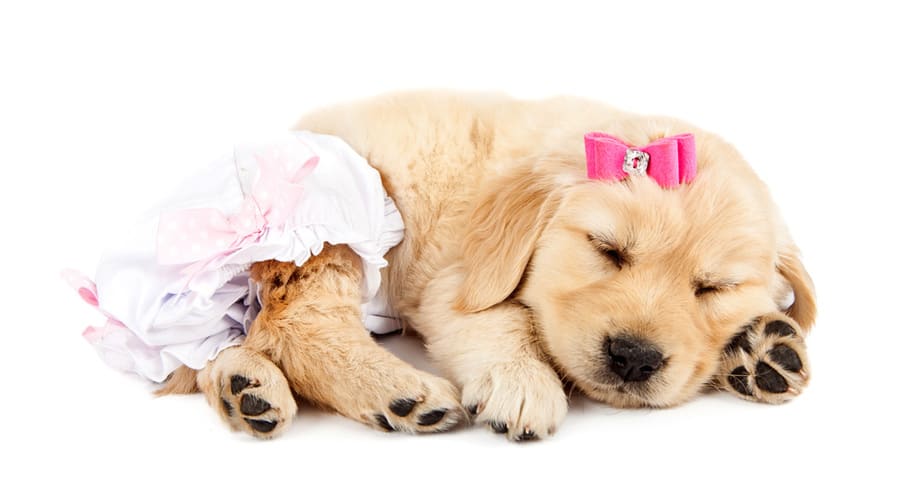
When is a puppy’s bladder fully developed?
A puppy’s bladder isn’t fully developed until they are an adult. By 4-6 months of age a puppy will develop full control of their bladder and is able to physically hold their urine. A 6-month-old puppy still cannot hold their bladder as long as an adult dog, as their bladder will still be growing in size.
We put this chart together to coincide with information from the University of California’s Davis College of Veterinary Medicine:
| Age of dog (weeks) | Frequency of urination (per day) |
|---|---|
| 6 – 14 | 8 – 10 |
| 14 – 20 | 6 – 8 |
| 20 – 30 | 4 – 6 |
| 30+ | 3 – 4 |
Puppy bladder development: Before birth
Dogs are pregnant for an average of 63 days (or 9 weeks). Organs, including the bladder, will develop by week 6. However, the bladder is still emptying into the umbilical cord before puppies are born. Emptying wastes directly into the uterus would not create a good environment for the puppy to develop!
The bladder connects to the umbilical cord via a structure called the urachus. This structure closes at birth, allowing a puppy to urinate as expected.
In some cases, the urachus doesn’t close properly. We’ll talk more about potential problems that arise in a developing bladder later on.
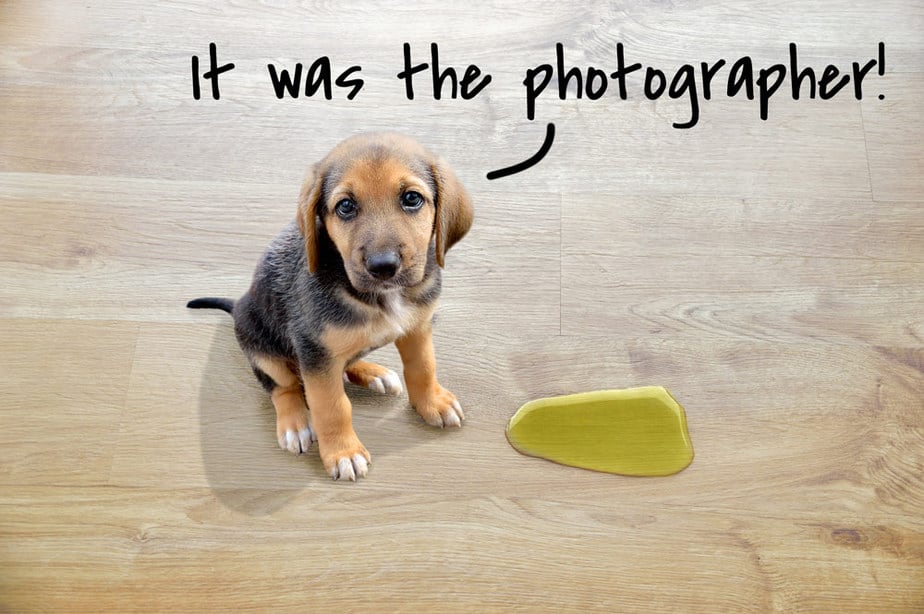
Puppy bladder development: Birth to 4 weeks
When puppies are first born, they not only don’t have the ability to hold their bladder, but they also can’t use the bathroom on their own. Instead, a mother dog (often called the dam) must stimulate the puppies to poop and pee by licking them.
The dam will often lick the puppy’s bottoms after each time they nurse, which usually occurs every hour or two.
Within a minute or two of her stimulating the puppies to use the bathroom, a very young puppy will urinate or defecate (which is often cleaned up by the dam continuing to lick at her pups).
This is in part to help keep the area with the puppies clean, as they aren’t able to move much on their own yet.
Around 2-3 weeks of age, a puppy will begin to become more mobile, their eyes and ears will open, and they’ll start to be able to interact with the world around themselves more.
By the time a puppy is 3-4 weeks old, they are able to go to the bathroom on their own.
It’s at this point that you will often see a puppy start to move away from their resting area to use the bathroom before crawling back to the warm pile of puppies.
Puppy bladder development: 5-16 weeks
Once a puppy has started to move on their own and use the bathroom of their own accord, it’s time to instill good potty training habits to ensure they continue to choose a specific place for the bathroom.
At this point, most responsible breeders will start to teach the puppies how to use a litter box or another designated area for the bathroom. Using alfalfa pellets is a great way to instill in the puppies to seek an area smelling of grass!
Dogs that are raised in an unclean environment, such as that which is often found in a puppy mill or some backyard breeder situations, may lose this natural instinct to seek out a place separate from sleeping to use the bathroom.
This is because if the puppy isn’t kept in a clean environment with a designated toileting area, they are unable to sleep separate from their urine and feces, and it becomes normal to the puppy.
A puppy’s bladder is still developing during this time, and they do not have full control of their bladder.
Because accidents will still happen during this time due to a lack of physical ability to hold their bladder, it’s critical to be consistent with good potty training methods.
This consistency and continued mental development regarding appropriate places to use the bathroom is important for a puppy to be able to be house trained fully in the future.
Thus, from 5-16 weeks of age, it’s more important to focus on building good mental skills regarding potty training and bladder control than worrying if your puppy has occasional accidents.
Because this process starts at 4-5 weeks of age, purchasing a dog from a breeder or a foster program that raises puppies with a litter box and potty training skills will make house training when you bring them home a breeze.
If your puppy pees a lot, then be sure to read our post Puppy Peeing a Lot: 5 minutes, 10 minutes, What is Normal?
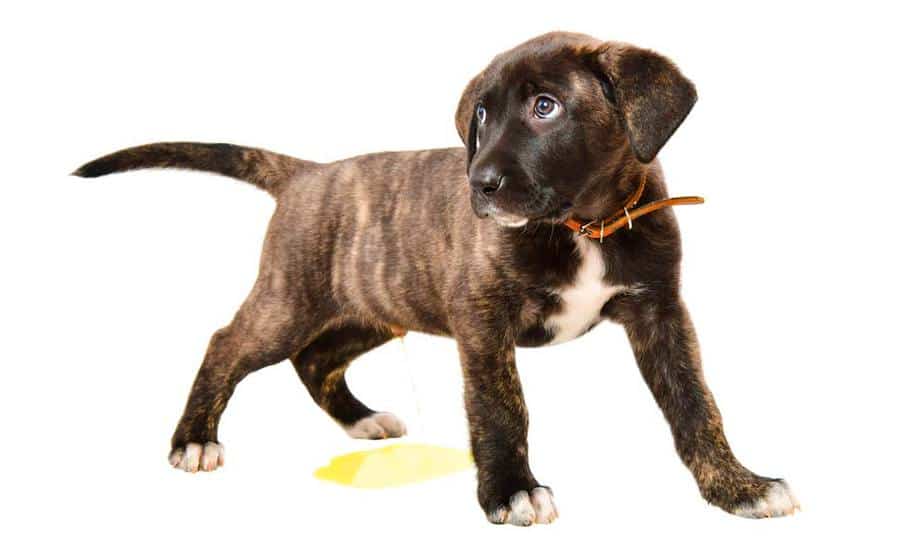
Puppy bladder development: 4-6 months
Your puppy’s bladder will be fully developed at some point between 4-6 months of age. It’s at this point that your puppy will be able to hold their bladder and you should see few, if any, accidents.
If your puppy is still having regular accidents after 6 months of age, it’s important to contact a trainer and a veterinarian ASAP.
With most potty training problems, the first step is to visit a veterinarian to rule out a medical problem.
There may be a urinary tract infection, structural defect, or another medical reason that your puppy isn’t able to hold their bladder.
After visiting a veterinarian, if medical problems have been ruled out, it’s time to meet with a trainer to figure out a plan for potty training.
Knowing the stages of puppy bladder development is important when setting expectations for potty training your puppy.
It’s often comforting to know that even if you’ve had your puppy for several months, the occasional accident may still happen because they physically do not have control of their bladder.
However, this should stop around 4-6 months of age as your puppy develops full control of their bladder and is able to physically hold their urine.
A 6-month-old puppy still cannot hold their bladder as long as an adult dog, however. Their bladder will still be growing in size (and they will continue learning the signals of needing to use the bathroom earlier) until they are an adult.
If your puppy is seeing in the house as they get older, watch that it’s not in fact marking that they are doing. For more information on this, be sure to read our post Will my puppy stop marking after being neutered?
Problems with bladder development
A lack of ability to hold their bladder when potty training can sometimes be attributed to a physical or medical problem, rather than a behavior problem. This is especially true if you’ve followed a good potty training plan and worked with a veterinarian and trainer already.
Urachal remnants
One of the more common bladder problems in puppies is due to urachal remnants.
In normal puppies, the urachus cord extends from the bladder to the navel (belly button) – and it connects to the umbilical cord before puppies are born so their bodily wastes can be removed.
In some cases, though, the urachus doesn’t close. Various parts of the urachus can remain open, leading to disorders called patent urachus or an umbilical urachal sinus.
If this happens, your dog will have urine attempting to leave the bladder through both the urethra and the umbilicus.
Besides when the urachus doesn’t close properly, it may also develop small sacs or cysts that lead to problems as well.
Common symptoms of a potential problem with your puppy’s urinary system include:
- Inability to control urination
- Urine scalding on the skin near the navel
- Urinary tract infections
Treatment for a persistent urachus requires surgery to close or remove the urachus. Antibiotics are often prescribed afterwards as well, especially if your puppy was already suffering from a urinary tract infection.
Ectopic ureter
Another common problem is called an ectopic ureter. In a normal dog, the ureters carry urine from the kidneys to the bladder, where it is stored until voided.
However, with ectopic ureters, one or both of the ureters skip connecting to the bladder and instead connect directly to the urethra or vagina.
In this case, you will likely notice that your puppy dribbles urine because they cannot contain it within their bladder.
While patent urachus and ectopic ureters are some of the most common bladder problem in puppies, there are other potential problems that can arise as well.
Other defects
In some cases, dogs have been found to have these defects:
- More than one bladder
- An underdeveloped bladder
- No signs of a developed bladder
- A bladder that is inside out
Besides physical examination, your veterinarian may want to take x-rays using a contrast dye so they can follow your puppy’s urine throughout their system.
The dye will make sure they can see any structural abnormalities that may be present.
Puppy Bladder Control
How long a puppy can hold their pee is determined by their age. The calculation is determined like this: A puppy can hold their pee every hour for every month they are old. This chart illustrated this calculation:
